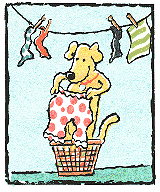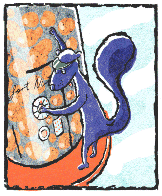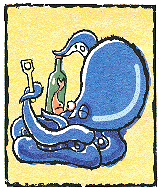 |
So who's a clever boy then?
|
Dumb animals? No way,says the concluding part of Clever Dicks,which this
week narrows the field for the title of animal Mastermind
Gareth Huw Davies
 Caring canines
Caring canines
Dogs are descended from wolves. Breeders have isolated their best, wild
qualities, fast forwarded evolution with selective breeding, and given us
pooches that do the supermarket shopping for disabled people and collect
their money from the cashpoint. The smartest seem to solve problems using
insight, not purely by trial and error. In Clever Dicks, Frodo the
labrador loves washdays. He empties the washing machine for his disabled
owner Stephanie. Then he tugs the basket full of wet things into the garden
where he gently nudges them over to Stephanie to hang up. Forgotten the pegs?
Leave it to Frodo. And the busy housedog still has time to open the door
and let in the cat.
Literary lions
The clever, communal self-preservation strategy of some Californian
sea lions
is now a tourist attraction.They used to haul themselves up on rocks, but
the incoming tide had a habit of invading their sleep. And great white sharks
added a nightmare dimension. Their solution is to bed down in safety on floating
pontoons in San Francisco harbour. The traditional image of the circus sea
lion - balancing a ball on its nose - is for losers. Real sea lions read.
They can tell their A, B, C from their 1,2,3. In a test they were shown a
letter, and to win a fish they had to press a board - the one with a (different)
letter- right; or a number - wrong. No need to phone a friend, or ask the
audience. They were right every time.

Safe -cracking squirrels
Grey squirrels are old troupers on the clever animals circuit. You loved
them in the BBC series Daylight Robbery. So what keeps them at the
top? Dexterous front paws, an amazing curiosity for anything new, and a dogged
determination to never, ever give up. Where you see a bird-feeder full of
nuts, squirrels behold a feast that's just asking for freedom. In the
intelligence trials, garden squirrels were let loose to roadtest the latest
fiendishly ingenious bird feeding models, all finished to Fort Knox standards
of impenetrability. The squirrels took a first-half drubbing but once they
worked out the defence, there was only one result. We can't wait for the
rematch.
Dexterous dolphins
In the wild they are credited with lifesaving, baby-sitting and providing
therapy to sick people.
In captivity they perform intricate routines and understand complicated spoken
instructions. It's a product of their sociable nature and a long youth which
is full of learning. Give them the handbook and they could probably rule
the world. Captive dolphins were shown a Perspex
tank with a fish in it. Two foreign objects were
added -a weight and a pointy thing. They worked out that putting the weight
in the top of the box released a trap door, which then allowed them to probe
the pointy thing into a panel, thus releasing the fish. Now the dolphins
want the real test to begin.

Arms and the octopus
Octopuses are the primates of the undersea world,
having the biggest brain of any invertebrate (creature without backbone),
with extremely sharp eyesight and amazing memories. This puts them among
the star problem - solvers of the wild. They are also great cowards - the
ability to know when to run away is another sign of cleverness. So does helping
itself to a crab from a crab pot present much of a challenge? Too easy. Squirming
through a Perspex maze for a fish? Piece of cake. In the end this touchy-feely
cephalopod was shown a fish in a bottle, which
was inside a second bottle. It gave it the full octo-twist and unscrewed
both tops in minutes to extract its tasty reward.
Precocious parrots
The kea, an alpine parrot from the mountains
of New Zealand, is a very bright bird indeed. It will investigate anything
new to see if it can he pulled out or taken apart and maybe eaten. Tugging
the laces from walkers' boots is a speciality. Keas also have an interesting
spin on car maintenance. They can take visitors' cars apart - mirrors, lights,
hubcaps, wipers, the lot. A kea says: "This BBC geezer turns up on our mountain
with a tube full of little trapdoors. We pull a few levers and some cheese
falls out. Simple. We do five more they thought were harder and harder. Easy.
Last is this long tube with eight rods to pull, levers to yank and buttons
to press. Took no time. Are humans stupid?"
Whose a clever boy then?
Question How do parrots talk or speak? Are their larynxes,
tongues or brains different to other birds? Margaret Turpin , Malborough
Wiltshire
Answer Parrots are unusual. In most birds, sounds are
created by a set of vibrating membranes in a pair of syrinxes the
lower larynx or voice organ in birds. One is found at the top of each bronchus
coming from the lungs. But parrots have only one syrinx, situated at the
bottom of the windpipe just above where the two bronchi meet. This is similar
to humans, who also have only one sound-producing organ: the larynx. Unlike
most other birds, parrots also have very long and muscular tongues, which
may be important in modifying sounds. Using the throat, mouth and tongue,
parrots can alter dominant sound frequencies or "formants" to give the sound
they want to make. For example, a parrot can make an "ee" rather than an
"ah", sound by opening its beak wider and pushing its tongue farther forward.
The parrot also has forebrain areas involved in vocal learning and control
of vocalisation that are not found in other birds. Broad parallels can be
drawn with similar areas specialised to deal with language in humans. That
helps explain why parrots have such versatile vocalisations, but there is
a debate over whether parrots can learn anything similar to language. They
can utter "sentences" consisting of words in an order that makes grammatical
sense. However, it is unlikely that they are using syntax in the way humans
do. It seems far more probable that they are following inflexible "rule-governed
behaviour": that is, they understand that a certain order of sounds must
be adhered to in order to achieve the task in question. Much of the debate
over the level of parrot language ability has been driven by the remarkable
research of Irene
Pepperberg and an African grey parrot called Alex
(New Scientist, 15 January 2000, p 40). With thanks to Erich D. Jarvis,
, The department of neurobiology Duke University Medical Center, Durham,
North Carolina, US |